TEAC Esoteric P-70 CD Transport and D-70 D/A Converter
| TEAC Esoteric P-70 CD Transport and D-70 D/A Converter |
|
Perfect Sound Forever |
|
Lewis Lanese |
|
June 2004 |
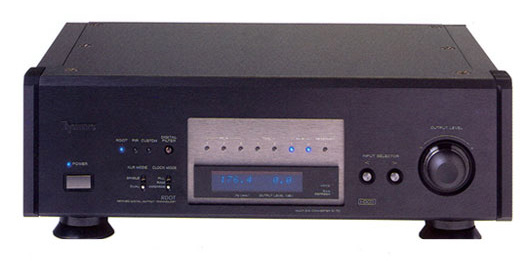
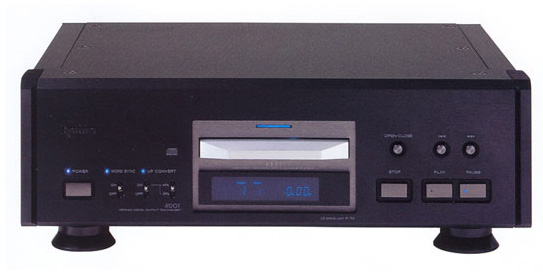
“Perfect sound forever,” or so the claim went twenty-four years ago when CD broke upon the audio scene. Twenty-four years. It seems almost like yesterday that digital was going to replace vinyl. Many music lovers actually did abandon their LP collections, but not all. As some of us began to discover, CDs were not all they were cracked up to be. There were unfamiliar distortions and artifacts that contributed to listening fatigue. It reminded me of the ‘60s when transistors burst upon the audio landscape and many predicted the end of tube equipment. Before long, some of us began to realize that we were simply hearing different kinds of distortion from that of tube equipment – again listening fatigue set in. But in both cases things changed.
Technology brought about vast changes in the applications of transistors as manufacturers produced some of the most coveted amps, preamps, etc. available. Tubes also had a renaissance beginning sometime in the ‘80s. Today’s audiophile can choose from among the finest in tube and solid-state equipment.
Vinyl re-emerged with the development of outstanding new tone arms, cartridges and turntables. Many small companies are reissuing LPs and young music lovers are beginning to discover the joys of vinyl.
Meanwhile, record companies turned to improving the aging CD with over- conversion/up sampling and a replacement for the “perfect sound” with the development of SACD and DVD-A (and the beginning of a new format war). But “Red Book” CD was not yet dead, as dCS, Zanden, and others have demonstrated. That brings me to the CD equipment now under consideration, the TEAC/Esoteric P-70 CD Transport and D-70 D/A Converter.
What an achievement! The P-70 and D-70 may make you wonder what all the fuss is about with SACD and DVD-A. These two gorgeously built and technically advanced units – transport and DAC – are for me, beyond anything I have previously heard from ordinary CD playback. Yes, I know, I was also enthusiastic over Sony’s SCD-1 SACD player in an earlier ST review, particularly the SACD’s level of articulation, resolution and the lack of artifacts common with CD playback. And the SCD-1 was also capable of really good CD playback – as good as some of the best I had previously heard. I well remember my reaction to the totally unexpected, massive build quality from Sony. Here was one of the giants of mass produced consumer electronics sparing nothing in the pursuit of a high-end, audiophile product and one that weighed-in at around 50 lbs. At $5,000 it seemed like a giveaway. Krell’s excellent flagship CD player retailed for several times the price and it didn’t include SACD.
FEATURES
Esoteric is TEAC’s name for their high-end audio products. They have spared nothing in the design and execution of the P-70 transport and the D-70 D/A converter. Each can be paired with a complementary unit from another manufacturer, but I chose to review Esoteric’s statement products together. Considering the steep price of the P-70 and D-70 combination ($7500 and $6500 respectively), a thorough discussion of the features of the two units is warranted.
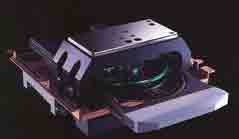 The 55-pound P-70 has some unique and proprietary features. It uses what TEAC calls a VRDS mechanism (Vibration-Free Rigid Disc-Clamping System) that clamps the CD to the turntable – the shape of which corrects for any warp in the disc and eliminates unnecessary vibration and decreases disc read error rate. The clamping system also helps to prevent timing errors. The transport uses a twin-transformer structure completely separated from the mechanical and digital signal systems for additional interference rejection. According to TEAC:
The 55-pound P-70 has some unique and proprietary features. It uses what TEAC calls a VRDS mechanism (Vibration-Free Rigid Disc-Clamping System) that clamps the CD to the turntable – the shape of which corrects for any warp in the disc and eliminates unnecessary vibration and decreases disc read error rate. The clamping system also helps to prevent timing errors. The transport uses a twin-transformer structure completely separated from the mechanical and digital signal systems for additional interference rejection. According to TEAC:
The P-70 can achieve word synchronization by accepting a master clock from any suitably-equipped D/A converter. With the converter acting as the master clock, any jitter resulting from data transfer between the player and the converter is essentially eliminated.
TEAC has developed a high-rigidity chassis with the VRDS mechanism of 20 mm extruded aluminum attached directly to 8 mm sheet steel. The front panel and sides are a twin layer design, 1.6 mm sheets plated with copper then nickel, to remove internal interference and optimize sonic performance. To further eliminate vibration, triangular pinpoint feet of case-hardened tool steel are used.
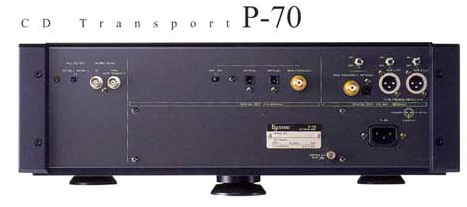
The transport has seven digital outputs altogether:
• Four (two XLR, one RCA and one TOS) handle the high-speed multiplied digital outputs – 24 bits at 88.2kHz, 24 bits at 176.4kHz
• Three (one RCA and two TOS) for 44.1kHz.
The dual AES spec is output from the twin XLR terminals.
The algorithm in the converter multiplier circuit, the RDOT method, is exclusive to TEAC. Besides the usual front panel controls and displays (power, open/close, play, etc.), there are also on/off switches for “word sync” and “up-convert” (either 24 bit/176.4kHz or 24 bit/88.2kHz). All switches and the front panel display are illuminated in blue LEDs. The front panel display may be turned off. The formidable remote unit, besides incorporating some of the front panel controls, also provides many additional controls. There is a PLL (phase-locked loop) filter switch on the back panel labeled Mode 1 and 2. Mode 2 is used with the D-70 which, TEAC claims, almost completely eliminates jitter.
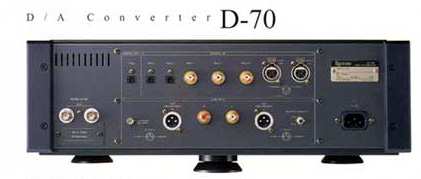
Now, let’s take a look at the features of the D/A converter. The filtering in TEAC’s RDOT (Refined Digital Output Technology) is equivalent to 24-bit/96kHz input enabling the D-70 to read the latest CDs with sampling frequencies up to 192 kHz. The front panel/remote provides three filter choices: RDOT has a slow roll-off and allows up to 16 times multiplication; FIR has a sharp roll-off and allows up to eight-times multiplication; and CUSTOM combines RDOT and FIR “…allowing the best characteristics of each filter”. The up conversion allows a maximum of 24 bit/768kHz! With the dual-wire (XLR) input, conforming to the AES 3 standard, the converter can accept data at 176.4kHz or 192kHz. The D-70 provides an HDCD decoder to play HDCD recordings. With the digital filter set to CUSTOM, the HDCD indicator lights when an HDCD disc is played.
TEAC also includes 128Mbits of RAM Link buffer (Refined Asynchronous Memory Link) to eliminate jitter, allow high bit-rate and high frequency sampling and make it unnecessary to continuously adjust the clock frequency. “The DAC is locked to a direct crystal-controlled fixed-frequency clock.” On the left and right channels there are three kinds of analog filters that are chosen automatically depending on the sampling frequency. Finally, the D-70 uses four multi-bit DAC Burr Brown PCM1704 units.
I know, this is a hellava lot of technical information to digest (and probably many of you will skip it), but at $14,000 for the two units you may want to know what you’re getting for your money.
SETUP
I followed TEAC’s setup recommendation for connecting the P-70 and D-70 together:
• Two XLR cables from the D-70 input terminals to the P-70 corresponding XLR output terminals – XLR output terminal switches set to ON
• BNC coax cable from the D-70 WORD SYNC OUT to the P-70 WORD SYNC IN and the PLL FILTER switch set to MODE 2
• P-70 Front Panel switches – WORD SYNC switch ON; UP CONVERT switch ON , “4Fs” selected
• D-70 Front Panel switches – clock mode, WORD+RAM; AES3 to DUAL; digital filter to “CUSTOM”
• SIGNAL GND between P-70 and D-70 connected together.
By pressing the menu button once, the value of the current sampling frequency can be selected – I chose 176.4, 192kHz. Pressing the menu button again allows the current frequency of the word signal to be changed. Since the P-70 is connected to the D-70, I selected 88.2.
The D/A converter provides a digital volume control on the front panel to adjust the output level from 0 through -60dB in 0.1dB steps. The D-70 can be connected directly to the amplifier bypassing the pre-amp/line stage. Most of my listening was conducted with the direct amplifier connection.
THE SOUND
My living room is about 24’ x 16’ with a cathedral ceiling about 9’ high in the center, sloping to about 5’10” at either end. My Piega P10 Reference loudspeakers are about 8’ from the rear wall and nearly 10’ apart measured from the center of the speakers. My far-field listening position is almost 14’ away, although occasionally I listen in the near-field. The speakers are angled in and cross just in front of where I sit. Although I didn’t consciously follow the 1/3 rule-of-thumb in set-up, that’s where the speakers sound the best.
It hit me on the very first disc – I have never heard such a wide and deep stereo stage from my system! And for the first time in all the years listening to my system, the speakers completely disappeared. This was my reaction when I played the Classic Compact Disc’s reissue (CSCD 6049) of Grieg’s Peer Gynt – Incidental Music (Oiven Fjeldstad conducting the London Symphony Orchestra). The original London/Decca recording from the late ‘50s was an early stereo recording using Decca’s three mic “Tree”. The sound was very detailed yet silky smooth with the orchestra delineated across the stage giving a natural sense of depth, wide dynamics and realistic bass. I had a similar experience to David Benoit, Urban Daydreams[GRP Records GRD 9587]. In my notes I had written, “The stage doesn’t get much deeper than this”. Another listening pal of mine remarked, without any coaxing, that this was the first time he was able to sit on either end of the sofa and experience the stereo stage. I attribute this experience primarily to the Esoteric as well as the Acoustic Zen cables, the Acoustic System resonators and Isolation Equipment Racks. When I switched to vinyl, the experience was similar but not quite to the extent I had with the P-70/D-70.
In the digitally remastered 1963 recording, John Coltrane and Johnny Hartman [Impulse GRD-157], the big voice of crooner Johnny Hartman has previously sounded detached from the playing of John Coltrane’s Quartet. Not so here – Hartman sounds more a part of the group, the recording sounding a bit more relaxed. Trane provides the ideal accompaniment, the saxophone nearly tangible. This is certainly a disc to treasure! If you love Sinatra singing ballads, you will love Johnny Hartman’s way with ballads.
“This One’s for Blanton“ was another revelation for me! Take the first cut, Do Nothin’ Till You Hear from Me [Pablo PACD-2310-721-2], with Duke Ellington, piano and Ray Brown, bass. In the opening bar, Ellington strikes, I believe, the first treble key. I don’t remember hearing such life-like reproduction. There is a grand piano in my living room – I could have sworn that those first eight strikes on the key were coming from that grand! All the transients of the attack were there – uncanny reproduction!
The Esoteric will expose a poor recording (and I discovered several) as readily as it glorifies a beautifully recorded CD. I have never heard a CD player reproduce the sound of an orchestra’s string section that is comparable to what I’ve heard on vinyl until now (with the exception of a few SACDs). I was beguiled by the reproduction of Mozart’s Sinfonia Concertante, K.364/320d [Sony SK 89488] from the P-70/D-70, glorious string tone with none of the hardness I’m so used to hearing from CD.
One of the most interesting comparisons was to see what the up-converting capabilities of the Esoteric were. I chose two sets of CD recordings. The first set was a recording from 1962 of Brahms’ Piano Concerto No. 1 in D minor, with Clifford Curzon and George Szell conducting the London Symphony Orchestra [Decca 417 641-2 and Decca 28904660376-2]. This recording is by the famous Decca team of that era: producer, John Culshaw; and recording engineer, Kenneth Wilkinson. The first Decca was reissued in 1987. The second, reissued in 1999, is a 96kHz 24-bit, Super Digital Transfer. The second set was a recording from 1963 of Britten’s The Young Person’s Guide to the Orchestra, with Benjamin Britten conducting the London Symphony Orchestra [Decca 425 659-2, reissued in 1989; and JVCXR-0226-2, 24 bit, super analog, recently reissued].
Wow! How enlightening was this comparison! There is no doubt whatsoever about the advantages of up-converting and no doubt that the P-70/D-70 is capable of making the most of it. In both cases a veil was lifted from the recordings, revealing the extended resolution and bringing a clarity not in the earlier reissues. It was as if the music suddenly came alive! The two reissues of the Brahms I had heard several times prior to the Esoteric and yes there was a difference – but nothing like this. I expected the JVC to easily highlight the differences in the two reissues of the Britten recording and this it most definitely did. The drums and cymbals became palpable compared to the Decca reissue – the performance became more exciting and thoroughly involving. This is not to say that the original recording was lacking as a performance – in fact it is the definitive performance of “The Young Person’s Guide to the Orchestra.“ An alternative recording on Teldec [9031-73126-2] pales in comparison. Since I had taken many notes on numerous other CDs I listened to, I could go on and on. But I think, i.e. I hope, I have already demonstrated the superiority of the TEAC Esoteric.
As I already noted, most of my listening was with the CD player connected with balanced cables directly to the Ayon monoblocks. But I did some serious listening with other setups, particularly with the balanced Calypso Line Stage. The Aesthetix added just a little heft to the mid-bass but in no way did it otherwise detract from the sonics, in fact it was remarkably neutral, and much to my surprise, with no noticeable colorations of its own.
I also listened to the Esoteric connected single-ended to the Croft preamp and from there single-ended to the amps. Although I preferred the sound with the balanced setup, the single-ended, Esoteric/Croft combination was excellent. If your present system is single-ended, “not to worry”, it isn’t necessary to replace your equipment and cables.
CONCLUSION
The beautifully designed, executed and technically advanced TEAC Esoteric P-70 and D-70 have so many outstanding features that they are, in my view, second to none. The wide, deep stereo stage that made the speakers disappear, the cohesive, articulate resolution and clarity it brought to so many CDs, the superb transient response, wide dynamics and realistic bass and the elimination of some of the artifacts and hardness I had come to expect from CD, all add up to what I consider to be one of the definitive CD transport and DAC combinations. I don’t expect to hear a superior CD combination in the near future. And if I do, I will be the first to say so. It renews my confidence in CD playback and makes me wonder if it is necessary to look toward SACD or DVD-A as the answer to something better. If you already own a separate D/A converter and your budget permits, consider replacing your transport – the Esoteric P-70 is that good. As for SACD and DVD-A, perhaps all that is necessary is up-converting/up sampling, 96kHz 24-bit in a “no-holds-barred” CD player.
TEAC will be releasing three new Esoteric products later this year: the X-01, SACD/CD player; the UX-1, a Universal Player; and the G-0, a Master Clock Generator. The X-01 and the UX-1 will each be priced at $13,000. However, they have made it clear that the P-70/D-70 will remain TEAC’s “Statement” (Red Book) CD products.
Specifications:
P-70, CD Transport $7,500
Pickup
Linear motor drive, objective lens drive, optical three beams
Digital output formats
Base sampling frequency. 44.1kHz, 88.2kHz, 176.4kHz: 24 bits
Digital Output Terminals: RCA (coaxial); XLR (balanced); OPTICAL (TOS)
Word synchronization input format
BNC – 44.1kHz, 88.2kHz/75 ohm
D-70 Multi D/A Converter, $6,500
Electrical characteristics (at 24 bit/44.1khz input)
Frequency response – 20Hz-20kHz, +/- 0.3dB; SN ratio, 116dB; Dynamic range 116dB; THD, 0.0025%; Channel separation, 115dB
Input levels
TOS x 3, -24 to -14.5dBm peak; SPDIF x 3, 0.5V; XLR x 2, 5V
Output levels
Analog: RCA, 2.2V; XLR, 2.2V; Digital: TOS, -21 to -15dBm peak
WORD SYNC: BNC x 2, TTL/75ohm
(P-70, D-70)
General
Power Supply: 120V, 60Hz; 25 watts
Dimension (WxHxD): P-70,465x162x355; D-70, 465x162x369 (mm)
Weight: about 55 lbs.
Esoteric, Divison of TEAC America, Inc.
7733 Telegraph Road
Montebello, CA 90640
(323) 726-0303
http://www.teac.com
![]()
Don’t forget to bookmark us! (CTRL-SHFT-D)
Stereo Times Masthead
Publisher/Founder
Clement Perry
Editor
Dave Thomas
Senior Editors
Frank Alles, Mike Girardi, Russell Lichter, Terry London, Moreno Mitchell, Paul Szabady, Bill Wells, Mike Wright, and Stephen Yan,
Current Contributors
David Abramson, Tim Barrall, Dave Allison, Ron Cook, Lewis Dardick, John Hoffman, Dan Secula, Don Shaulis, Greg Simmons, Eric Teh, Greg Voth, Richard Willie, Ed Van Winkle, Rob Dockery, Richard Doran, and Daveed Turek
Site Management Clement Perry
Ad Designer: Martin Perry





Be the first to comment on: TEAC Esoteric P-70 CD Transport and D-70 D/A Converter